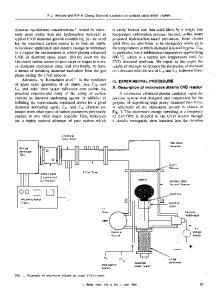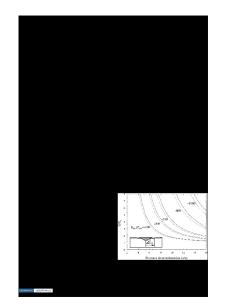A pretreatment process for enhanced diamond nucleation on smooth silicon substrates coated with hard carbon films
- PDF / 1,265,293 Bytes
- 6 Pages / 576 x 792 pts Page_size
- 38 Downloads / 335 Views
I. G. Brown Lawrence Berkeley Laboratory, University of California, Berkeley, California 94720
D. B. Bogy Department of Mechanical Engineering, University of California, Berkeley, California 94720 (Received 16 February 1994; accepted 19 April 1994)
Diamond nucleation on unscratched silicon substrates coated with thin films of hard carbon was investigated experimentally with a microwave plasma-assisted chemical vapor deposition system. A new pretreatment process was used to enhance the nucleation of diamond. Relatively high diamond nucleation densities of ~10 8 cirr 2 were achieved by pretreating the carbon-coated silicon substrates with a methane-rich hydrogen plasma at a relatively low temperature for an hour. Scanning electron microscopy and laser Raman spectroscopy studies revealed that diamond nucleation occurred from nanometer-sized spherical particles of amorphous carbon produced during the pretreatment. The nanoparticles possessed a structure different from that of the original hard carbon film, with a broad non-diamond Raman peak centered at ~1500 cm"1, and a high etching resistance in pure hydrogen plasma. The high diamond nucleation density is attributed to the significant percentage of tetrahedrally bonded (sp3) atomic carbon configurations in the nanoparticles and the presence of sufficient high-surface free-energy sites on the pretreated surfaces.
I. INTRODUCTION Significant progress in the synthesis of thin diamond films has recently been achieved using plasma-assisted methods, especially diamond growth with microwaveproduced plasmas. The increasing demand for the development of new techniques, which can lead to the enhancement of the homo- and/or hetero-epitaxial nucleation of high-density diamond crystals without affecting the original surface topography, has stimulated interest in the use of different diamond-forming precursors. For example, carbon fibers,1'2 fullerene clusters,3'4 graphitic carbon,5'6 and amorphous carbon7^9 have been used to selectively grow diamond on unscratched substrates. The increased nucleation density of diamond in the presence of carbon fibers has been attributed to effects on the local gas phase chemistry1'2 and surface changes associated with the formation of both etch pits and silicon carbide particles.2 Although diamond nucleation enhancement has been reported for single-crystal silicon substrates coated with a thin layer of C70,3 the significant etching rate of fullerene molecules observed under diamond deposition conditions,4 presumably due to their high reactivity with atomic hydrogen and low heats of sublimation,10 suggests that diamond nucleation could not have commenced from fullerene clusters. Experiments involving diamond growth on silicon surfaces 2148
http://journals.cambridge.org
J. Mater. Res., Vol. 9, No. 8, Aug 1994
Downloaded: 14 Mar 2015
coated with various carbonaceous films, such as a mixture of C6o and C 70 , graphitic carbon, and hard carbon prepared by vacuum arc plasma deposition, demonstrated that the nucleation density increased apprecia
Data Loading...






